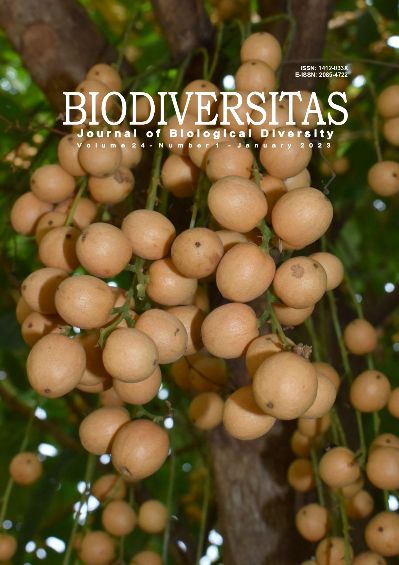Characterization of microplastic in trawl fish caught in Padang City (Indonesia) coastal area
##plugins.themes.bootstrap3.article.main##
Abstract
Abstract. Edwin T, Primasari B, Purnama RA. 2023. Characterization of microplastic in trawl fish caught in Padang City (Indonesia) coastal area. Biodiversitas 24: 516-522. Marine organisms can ingest microplastics that are distributed in the oceans. It can harm marine organisms because carcinogenic materials easily attach to microplastics. Trawl fish is a commercial fish with a high demand from people in Padang City, West Sumatera, Indonesia. This study aimed to analyze the abundance of microplastics in the gastrointestinal tract of fish. Also, analyze the microplastic characteristics in trawl fish caught on Pasir Jambak Coast and Purus Coast in Padang City. The species studied were Sulphur goatfish (Upeneus sulphureus), Indian mackerel (Rastrelliger kanagurta), and White sardinella (Sardinella albella). Microplastics were identified using microscopy and FTIR spectroscopy. Microplastic abundance in Sulphur goatfish, Indian mackerel, and White sardinella was 3.89±1.36 per fish, 4.22±1.28 particles per fish, and 2.50±0.46 particles per fish, respectively. The size of the most commonly found microplastics ranged from 1-5 mm and was categorized as the Large Microplastic (LMP) type. Fourier Transform Infra-Red (FTIR) spectroscopy analysis showed that the origin of the type of microplastic polymer found was Polyethylene Terephthalate (PET). Statistically, it shows that the difference in the location and time of sampling does not provide a significant difference in the concentration of microplastics in fish and seawater. The results of this study indicated that microplastics were found in the waters and all fish samples on the coast of Padang City studied. Microplastics in the trawl fish can be used to manage plastic waste in the city to prevent a worse impact due to plastic pollution in the future.
##plugins.themes.bootstrap3.article.details##
Most read articles by the same author(s)
- PUTI SRI KOMALA, RESTU MAULIDA AZHARI, FEBI YULIA HAPSARI, TIVANY EDWIN, TAUFIQ IHSAN, ZULKARNAINI, MUSTIKA HAREFA, Comparison of bioconcentration factor of heavy metals between endemic fish and aquacultured fish in Maninjau Lake, West Sumatra, Indonesia , Biodiversitas Journal of Biological Diversity: Vol. 23 No. 8 (2022)

